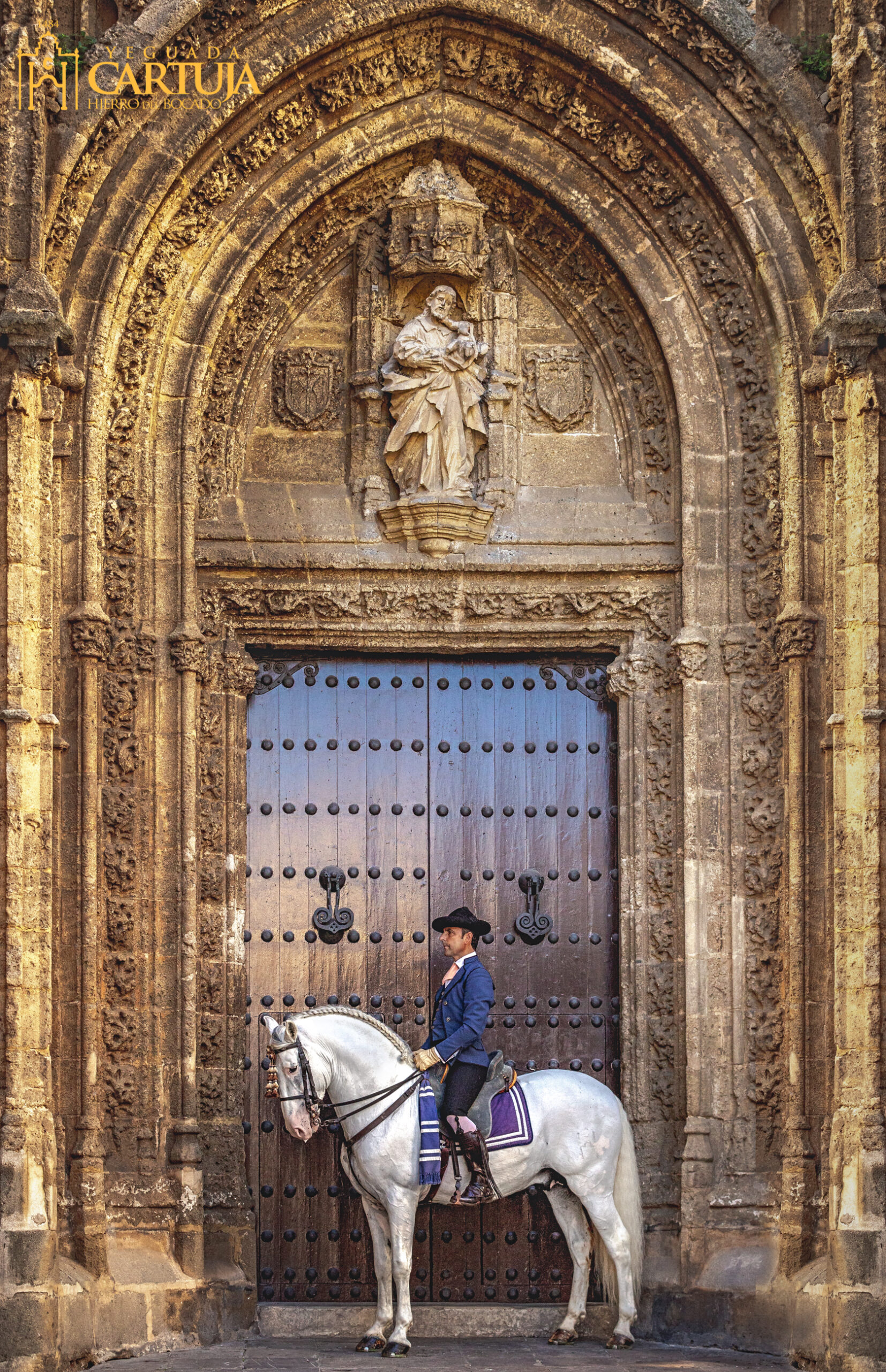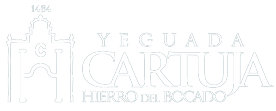About us
In the grounds of the old pasture of ‘Fuente del Suero’, close to the Carthusian Monastery in Jerez de la Frontera, nowadays, just as at the end of the XV century, you may see the legendary Spanish purebred Carthusian horses. A place where specimens of great purity graze and grow: Yeguada Cartuja Hierro del Bocado.

Historia
Since 1983, Yeguada Cartuja is part of the National Heritage.
The activities of this renowned stud farm take place in the Guadalete valley, the same natural area that, due to its climate and fertility, produces the famous sherry wines of Jerez.
Classical Antiquity
The livestock prestige of these lands dates back to classical antiquity. Virgil was fascinated by the harmony of the horses in southern Spain, and Publius Cornelius Scipio treasured horses from Lower Andalusia in his Roman mansion. The Roman Emperor Caligula, Richard the Lionheart, Frederick the Great and Napoleon Bonaparte also owned horses from the region.
Spanish horses maintained their prestige even during the long Muslim occupation. Over the centuries Jerez, the birthplace of horses, continued to be a source of world-renowned specimens. Following the discovery of America, Andalusian horses arrived in the New World to form the basis of its entire equine population. It also nourished some of the most important equestrian centres in Europe: the genetic origins of the Lipizza stud in Austria or the Fredericksborg stud in Denmark can be traced back to the southern Spanish horse. Today, privileged stud farms on five continents pride themselves on the fact that their horses have Carthusian blood in their lineage.
XV – XIX Centuries
A centuries-old tradition, which reached its splendour at the end of the 15th century, in the impressive Santa Maria de la Defension Monastery, becoming the cornerstone of Jerez horse breeding. The religious order of the Carthusian monks already had important breeding experience in other monasteries. The monks established a stud farm, which in time became one of the most famous and appreciated in the world.
Around the splendid Renaissance building of the Carthusian Monastery, erected a few kilometres from the town of Jerez, for four centuries, they carried out a painstaking livestock breeding activity that lasted until the beginning of the 19th century.
The War of Independence led to the plundering of the Jerez monastery, and the stud farm left the protection of these monks forever.
XIX Century
Fortunately, in 1810, the presbyter Pedro José Zapata saved this breed from disappearing by acquiring its best specimens. To brand them, Zapata used a new iron with a bit, thus giving his stud farm the name by which it is still admired all over the world. Years later, when Mr. Vicente Romero bought part of the stud farm, he added a “C” to Hierro del Bocado. The purity of the Carthusian lineage was preserved through successive ownerships: Mr. Vicente Romero Garcia, Ms. Rosario Romero, widow of Dominguez, Mr. Francisco Chica Navarro, the Viscount of Montesina, Mr. Juan Pedro Domecq and Nuñez de Villavicencio, Mr. Fernando C. Terry and Cuvillo and Ms. Isabel Merello, widow of Terry, are characters who, thanks to their loyalty and effort, have enabled the purity of Hierro del Bocado to survive to this day.
XX Century
In 1983, the breed became part of the Spanish Directorate General of State Heritage, which definitively took on the responsibility of maintaining and improving this genetic treasure, transferring its specimens to the ‘Fuente del Suero’ estate. Once again, the nearby Carthusian monastery is a historical and geographical reference point, as the estate had belonged to the religious order, which bought it in 1484 for 140,000 maravedis.
XXI Century
In the year 2002 coinciding with the final departure of the Carthusian Monks, the right of usage of the “Hierro de la Campana” (brand of the bell) was ceded to Expasa. As only condition given by the monks, was the fact that if the stud farm would be sold to private hands, the property and right of usage of that brand would go back to the Carthusian religious order.
Present-day
At present, the public company EXPASA is responsible for managing the stud farm. We have functional facilities dedicated to the breeding, study and improvement of the Carthusian lineage, with the fundamental objectives of safeguarding, maintaining and disseminating its genetic wealth.


EXPASA
The State Company EXPASA AGRICULTURA Y GANADERÍA, SME S.A. is a public trading company, whose sole shareholder is the Spanish State through the Ministry of Finance, Directorate General of State Assets, and whose functional supervision is carried out by the Ministry of Agriculture, Fisheries and Food.
Goal
To conserve, preserve, maintain and promote Yeguada Cartuja Hierro del Bocado stud farm as the world’s largest stud farm for Spanish purebred Carthusian horses and one of the oldest, most important and prestigious in the world.
To contribute to the development, promotion and innovation of the equine sector, becoming a meeting point for the equine sector nationwide, through the identity of the stud farm as a Spanish National Equine Zootechnical Reference Centre.
To offer society this genetic heritage and knowledge and to disseminate it to all citizens by means of various programmes of tours and collaboration with public and private entities and institutions.
Vision
To promote Carthusian horses as a sign of identity of Spain’s historical and cultural heritage and to make this legacy known to society as a whole, both nationally and internationally. All this, providing a renewed, integrative, innovative, technological and collaborative vision, contributing to the diversification of the economy in rural areas.
Values
Yeguada Cartuja Hierro del Bocado stud farm promotes the following values:
- Accountability, integrity and transparency
- Selection and quality
- Sustainability
- Service and outreach orientation
- Technological innovation and transfer to the sector
- Collaboration and alliances
